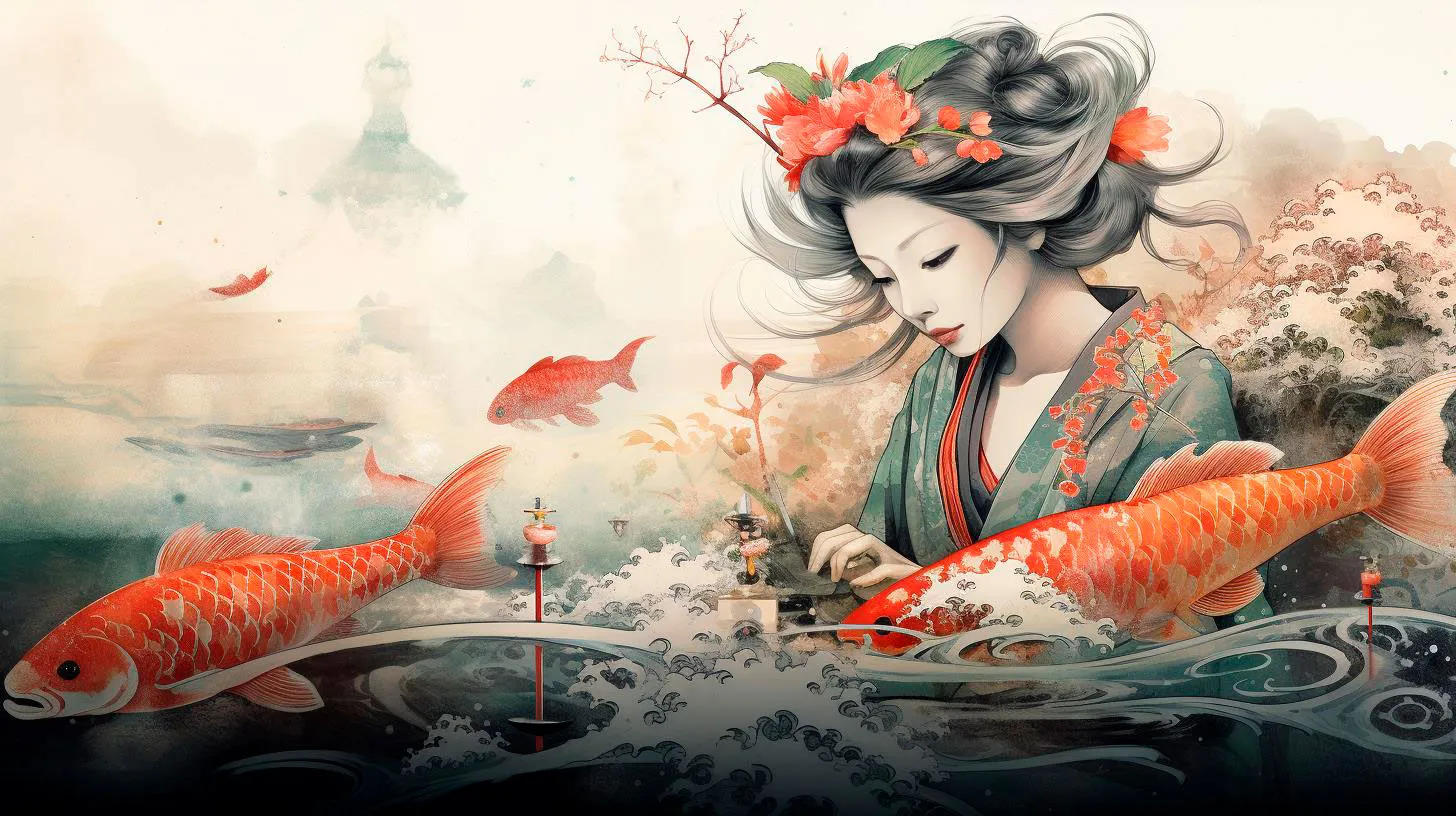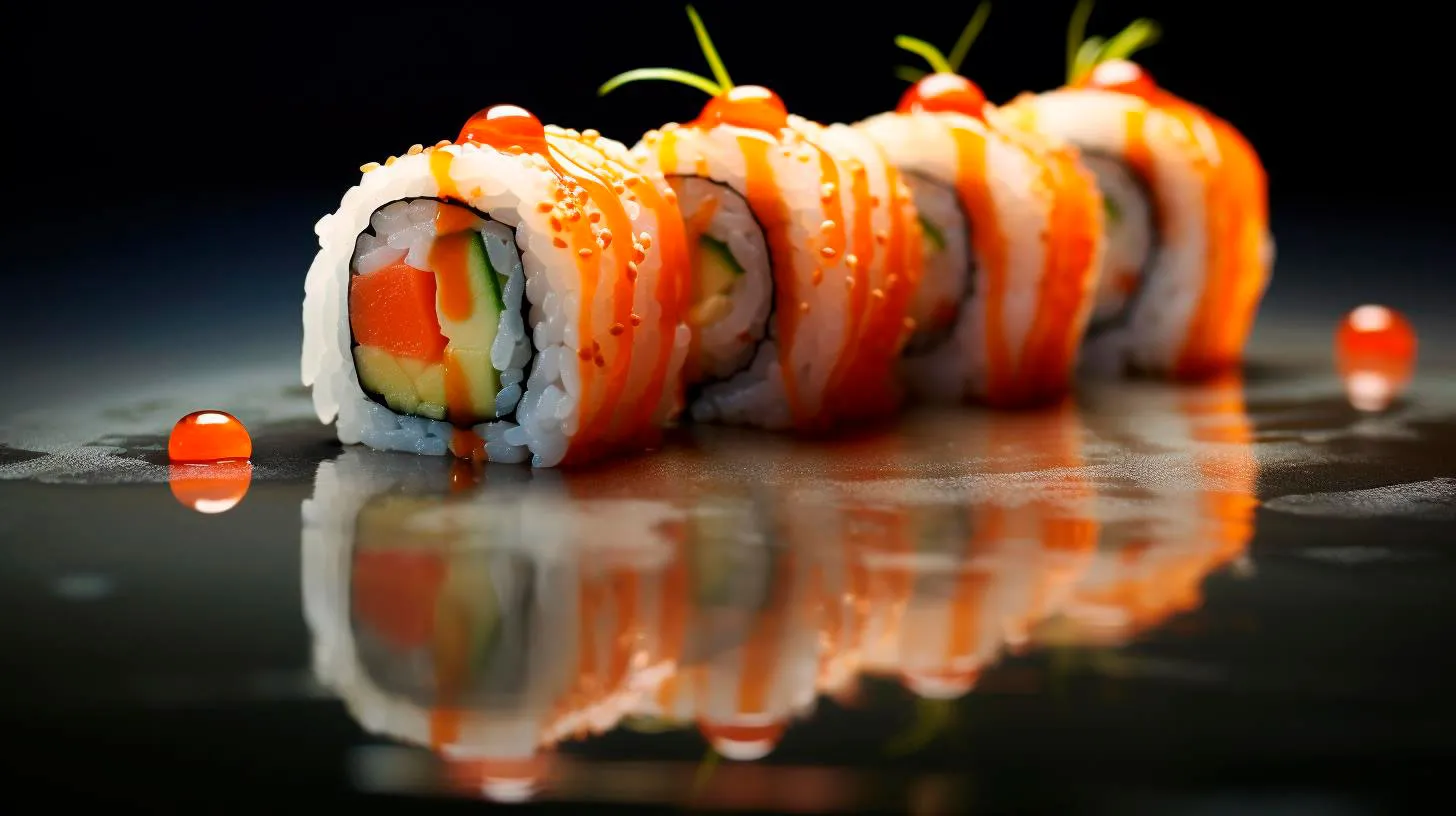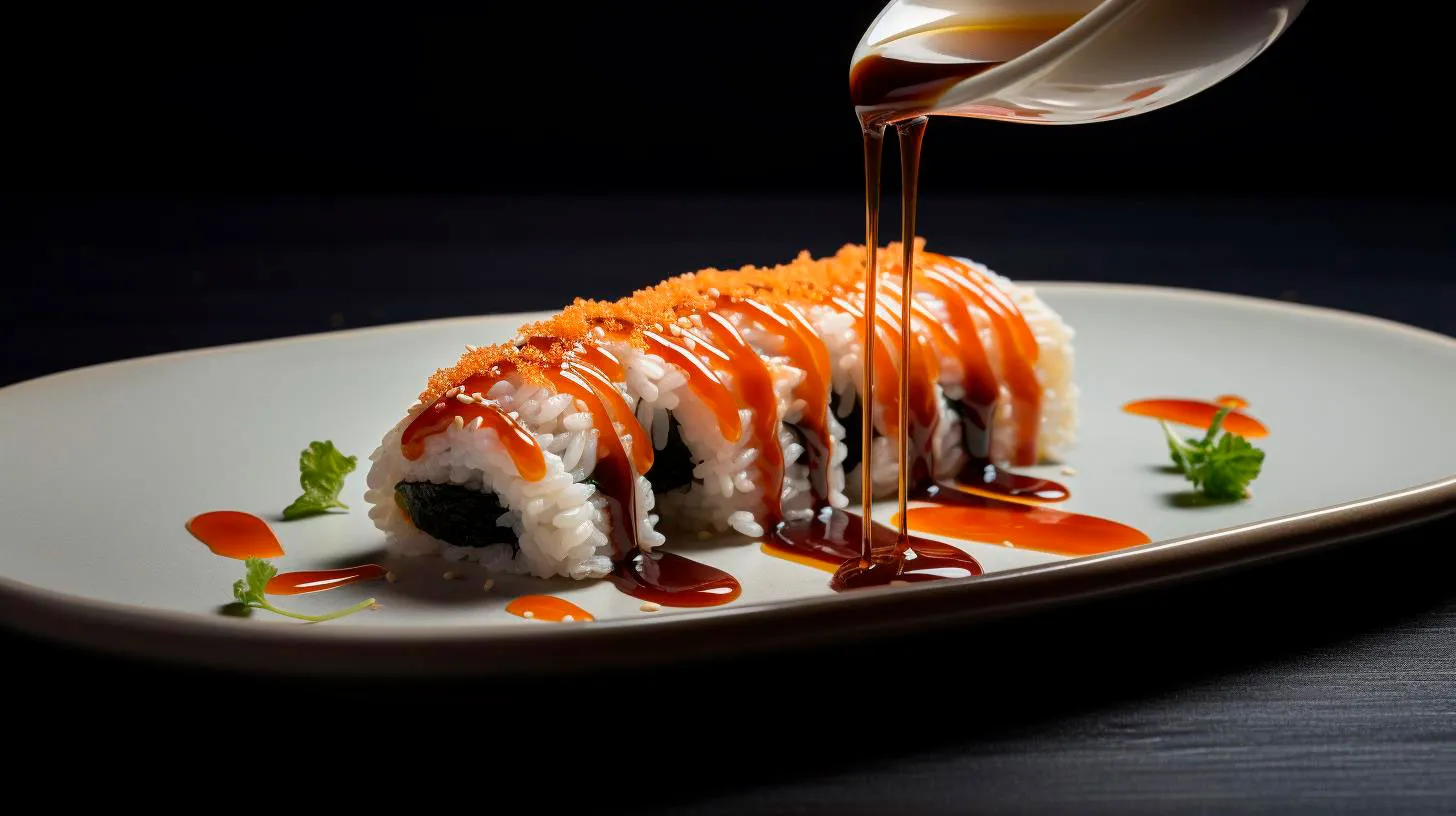Sushi: A Culinary Delight in Modern Japanese Festival Celebrations
In recent years, sushi has gained immense popularity, and it has become an integral part of modern Japanese festivals. Let’s explore the significance of sushi in Japanese festivals, its historical roots, and the reasons behind its wide appeal.
A Brief History of Sushi
Sushi, as we know it today, traces its origins back to Japan in the 19th century. However, its roots can be traced all the way back to ancient times when people in Southeast Asia used to preserve fish by fermenting them with rice. This salted rice was discarded, and only the fish was consumed due to its tangy flavor. Over the years, this preservation technique evolved, and during the Edo period, the style of sushi we recognize today emerged.
In the Edo era, sushi gained popularity as a fast food option among busy Japanese workers. They would enjoy it at roadside stalls known as “yatai.” The sushi vendor would use fresh seafood, rice seasoned with vinegar, and seaweed wrap to create the delectable treat we now cherish. Sushi’s popularity soared, spreading across Japan and becoming an integral part of celebratory occasions, including traditional festivals.
The Significance of Sushi in Japanese Festivals
Japanese festivals, known as “matsuri,” are a magnificent display of the country’s rich culture and traditions. These festivals bring communities together to celebrate various occasions, such as the changing of seasons, religious events, and historical milestones. The inclusion of sushi in these festivals stems from its symbolism and cultural significance:
- Celebratory Dish: Sushi is considered a celebratory dish in Japanese culture, symbolizing good luck, prosperity, and joy. Including sushi in festivals signifies the abundance of blessings and happiness.
- Seasonal Ingredients: Japanese festivals often coincide with the harvest of local ingredients. Sushi, with its versatility, allows chefs to incorporate the freshest seasonal seafood and vegetables, making it a delightful representation of the region’s flavors.
- Artistic Presentation: Sushi is not only a culinary delight but also a work of art. The meticulous arrangement of colorful ingredients on a sushi platter showcases the skill and craftsmanship of Japanese chefs. Festivals provide an ideal platform to exhibit this artistry.
The Wide Appeal of Sushi
Over the years, sushi has mesmerized food enthusiasts worldwide, and it continues to gain popularity for several reasons:
1. Health Benefits
Sushi offers a range of health benefits that attracts health-conscious individuals:
- Fatty fish varieties such as salmon and tuna are rich in omega-3 fatty acids, which promote heart health and reduce the risk of chronic diseases.
- Wasabi, a common sushi condiment, contains antimicrobial properties that help fight off bacteria and protect against foodborne illnesses.
- Nori, the seaweed wrap, is an excellent source of vitamins and minerals, contributing to overall well-being.
2. Culinary Adventure
Sushi offers a unique culinary experience, with its fusion of flavors, textures, and ingredients:
- Each sushi roll presents a delightful combination of fish, rice, vegetables, and condiments, creating a harmonious blend of tastes.
- From delicate sashimi to crispy tempura rolls, sushi offers a wide range of options catering to diverse preferences and dietary restrictions, including vegetarian and vegan choices.
3. Social and Cultural Experience
Enjoying sushi is not just about the food; it embodies a social and cultural experience:
- Sushi is often enjoyed in a group setting, encouraging social interaction and shared experiences.
- The art of sushi preparation and presentation reflects Japan’s cultural heritage, offering a deeper understanding and appreciation of Japanese traditions.
Key Takeaways
Sushi, a culinary delight rooted in Japanese history, has become an integral part of modern Japanese festivals. Its presence signifies celebration, joy, and the richness of local flavors. The wide appeal of sushi lies in its health benefits, culinary adventure, and social-cultural experience. As you delve into the world of sushi, remember to savor each bite as you embark on a journey of taste, tradition, and togetherness.
From Obscurity to the Mainstage: Sushi’s Rise to Prominence in Japanese Festivals
Let’s delve into the intriguing journey and explore the factors that contributed to sushi’s prominence in Japanese festivals.
The Evolution of Sushi in Japanese Festivals
Sushi has its roots dating back to ancient times when it was consumed as a pickled fish without rice. Over the centuries, sushi has evolved, with the introduction of vinegared rice in the Edo period (1603-1868), transforming it into the form that we recognize today. Initially, sushi was primarily enjoyed in sushiya (sushi restaurants) and exclusive dining settings. However, as Japanese festivals gained popularity, sushi started making its way into these lively events.
Factors Contributing to Sushi’s Festival Fame
- 1. Cultural Significance: Sushi represents a quintessential part of Japanese culture. Its inclusion in festivals highlights the rich culinary heritage of Japan and adds a touch of tradition to the vibrant celebrations.
- 2. Variety and Customization: Sushi offers endless possibilities when it comes to flavor combinations, fillings, and presentation. Its versatility allows it to cater to diverse tastes, making it an ideal addition to festivals where people have varying preferences.
- 3. Visual Appeal: Presentation is an essential aspect of sushi, and its colorful, artistic arrangement makes it visually appealing. Festivals provide the perfect platform for sushi to shine, with its vibrant colors and intricate designs captivating the attention of festival-goers.
The Rise of Sushi Vendors in Festivals
In recent years, sushi vendors have sprung up in Japanese festivals, offering a wide array of sushi options to eager festival attendees. The emergence of these vendors has played a pivotal role in sushi’s rise to prominence in such events.
One of the key advantages of sushi vendors is their ability to cater to large crowds swiftly. Sushi is served in convenient bite-sized portions, enabling festival-goers to enjoy the dish on the move without much hassle. This convenience factor has made sushi a popular choice among festival attendees who are looking for tasty and convenient food options.
Another crucial factor contributing to sushi’s festival fame is the fusion of traditional and modern flavors. While traditionally prepared sushi like nigiri and maki are still widely enjoyed, sushi vendors have also introduced innovative variations, such as sushi burritos and sushi burgers. This fusion of flavors enhances the overall festival experience, appealing to both traditional sushi enthusiasts and those seeking something new and exciting.
The Future of Sushi in Japanese Festivals
The presence of sushi in Japanese festivals shows no signs of slowing down. With the increasing popularity of these events among both locals and tourists, sushi vendors are continually innovating and adapting to meet the evolving demands. It is estimated that the revenue of sushi vendors in Japan reached an impressive ¥156 billion in 2020 alone, indicating the ever-growing market for festival sushi.
Furthermore, sushi vendors are embracing sustainability, a rising concern in the food industry. Eco-friendly packaging, responsibly sourced ingredients, and reduced food waste are becoming top priorities for sushi vendors. Not only does this contribute to the overall festival experience, but it also resonates with the values of conscious festival-goers.
Key Takeaways
- • Sushi has risen from high-end restaurants to become a prominent feature in Japanese festivals.
- • Cultural significance, variety, and visual appeal have contributed to sushi’s festival fame.
- • The convenience and fusion of traditional and modern flavors offered by sushi vendors have boosted its popularity.
- • Sustainable practices are becoming a priority for sushi vendors in festivals.
- • Sushi’s presence in festivals is expected to continue growing, driven by increasing demand and innovative offerings.
Sushi’s journey from obscurity to the mainstage in Japanese festivals is a testament to its versatility, cultural significance, and growing consumer demand. As sushi continues to evolve and adapt to changing culinary preferences, we can expect it to remain a star attraction at festivals, captivating taste buds and celebrating Japanese gastronomy for generations to come.
Sushi Takes Center Stage: A Traditional Staple with a Modern Twist in Festival Celebrations
In this blog article, we will explore how sushi has evolved over time, the advantages of incorporating sushi into festival menus, and the key takeaways of this modern twist on a traditional delicacy.
The Evolution of Sushi
Sushi, which literally means “sour-tasting,” originated in Japan around the 8th century as a way to preserve fish by fermenting it with rice and salt. However, over the years, sushi has undergone a significant transformation, both in terms of presentation and flavor. Today, sushi is often associated with bite-sized rolls filled with a variety of ingredients, including fresh fish, vegetables, and even tropical fruit.
One of the key elements in this evolution is the introduction of nigiri sushi, where slices of raw fish are placed on top of vinegared rice. This style of sushi showcases the freshness and quality of the ingredients, enticing diners with its simple yet elegant appearance. Additionally, sushi chefs have embraced creativity by introducing fusion flavors, such as spicy tuna or tempura rolls, which add a modern twist to the traditional dish.
Advantages of Incorporating Sushi into Festival Menus
As festival organizers and caterers strive to offer unique culinary experiences, incorporating sushi into festival menus holds numerous advantages. Here are a few key reasons why sushi deserves a prominent place in festival celebrations:
- Variety of Options: Sushi offers a plethora of options, catering to different dietary preferences and restrictions. From vegetarian rolls filled with avocado and cucumber to succulent sashimi slices, there is something for everyone.
- Visual Appeal: Sushi is not only a treat for the taste buds but also a feast for the eyes. The vibrant colors, intricate presentation, and artistic plating of sushi rolls add an element of visual appeal to festival menus.
- Health Benefits: Festival-goers are increasingly conscious of their health, and sushi aligns perfectly with their preferences. With its focus on fresh ingredients, lean proteins, and nutrient-rich seaweed, sushi offers a healthier alternative to traditional festival fare.
- Novelty Factor: While traditional festival foods have their charm, offering sushi as a part of the menu introduces a novel and exciting element. It provides festival-goers with the opportunity to explore a different cuisine and indulge in something unique.
Key Takeaways: Modern Twist on a Traditional Delicacy
As sushi takes center stage in festival celebrations, here are the key takeaways that highlight its significance and appeal:
- Fusion flavors: The fusion of traditional and contemporary flavors in sushi brings a delightful surprise to festival-goers.
- Artistic presentation: Sushi showcases the immense talent and creativity of sushi chefs, elevating the dining experience to an art form.
- Health-conscious option: Choosing sushi as a festival food reflects the growing emphasis on health and wellness, catering to a wider audience.
- Cultural appreciation: Incorporating sushi into festival menus offers an opportunity for cultural exchange and appreciation of Japanese cuisine.
In conclusion, sushi has evolved from its humble beginnings as a preserved fish dish to become a global sensation in festival celebrations. With its blend of tradition and innovation, sushi offers a unique dining experience that satisfies the taste buds while appealing to visual aesthetics. The advantages of including sushi in festival menus, such as its variety, health benefits, and novelty factor, make it a compelling choice for both organizers and attendees. So, the next time you attend a festival, keep an eye out for sushi, as it takes center stage in combining tradition with a modern twist.
Celebrating with Sushi: Exploring the Important Role of this Japanese Delicacy in Modern Festivals
Today, we will delve into the important role that sushi plays in modern festivals and its significance in creating memorable experiences for festival-goers.
The Evolution of Sushi in Festivals
Sushi’s journey from a traditional Japanese dish to a festival staple has been fascinating. Initially, sushi was primarily consumed during special occasions and religious festivals in Japan. However, as globalization took hold, the popularity of sushi skyrocketed, and it quickly became a favorite culinary delight among people from different cultural backgrounds.
In modern festivals, sushi has become a prevalent food option due to its versatility and ability to cater to diverse palates. Sushi lovers can enjoy a wide variety of options, including vegetarian, vegan, and gluten-free alternatives. Its flexibility in accommodating different dietary preferences makes it an inclusive choice for festival organizers seeking to offer diverse options.
Furthermore, sushi’s artistic presentation and vibrant colors make it visually appealing. Festivals often emphasize sensory experiences, and sushi perfectly aligns with this objective. The meticulous preparation and artistic arrangement of sushi make it an attractive centerpiece, adding to the overall ambiance and visual appeal of festival celebrations.
The Advantages of Incorporating Sushi into Festivals
The inclusion of sushi in modern festivals offers several advantages, making it an attractive choice for event organizers. Let’s explore some of the key benefits:
- Social Connection: Sushi, with its shared dining experience, creates an opportunity for people to come together and bond over a delectable meal. It encourages social interaction and cultivates a sense of community.
- Health Conscious: Sushi is often considered a healthier food option due to its focus on fresh ingredients and balanced portions. Festivals that incorporate sushi provide attendees with a guilt-free dining experience.
- Cultural Exchange: Sushi serves as a gateway to Japanese culture, allowing festival-goers to explore new flavors and culinary traditions from around the world. It fosters cultural exchange and promotes a deeper understanding of different traditions and customs.
- Menu Diversity: The wide range of sushi variations ensures that there is something for everyone. Whether you prefer sashimi, nigiri, or maki rolls, the diverse options cater to different taste preferences and dietary requirements.
- Unforgettable Experiences: Sushi’s intricate flavors and presentation create an unforgettable dining experience for festival attendees. Its unique taste and aesthetics add a touch of sophistication and elegance to celebrations.
Key Takeaways
Sushi has undoubtedly become a vital part of modern festivals, transcending cultural boundaries and delighting taste buds worldwide. Its versatility, visual appeal, and ability to foster social connections make it a perfect addition to any celebratory event. By incorporating sushi into festivals, organizers can provide attendees with a unique dining experience that promotes cultural appreciation and memorable moments. So, the next time you attend a festival, make sure you indulge in the flavors of sushi and immerse yourself in this extraordinary Japanese delicacy.
Remember, sushi is not just food; it’s a symbol of celebration, unity, and cultural diversity, allowing us to explore the world on a plate.



